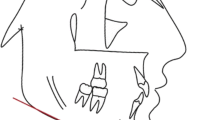Summary
To make a digital image database of human craniology, we optimized the three-dimensional (3-D) images of 29 dried human skull specimens by helical computed tomography (CT). For the verification of the quantitative exactitude of these image data, we manually measured nine items of direct distances between standard anthropologic points on each skull and the corresponding distances projected on the CT monitor by specifying the respective points. The results obtained by the two methods of manual and CT measurements were compared and statistically analyzed. The CT measurements were so exact that the lower limit of correlation coefficients (95% of the confidence interval) between the two results was more than 0.8 in six items; i.e., maximal cranial length and breadth, minimal frontal breadth, bizygomatic breadth, distance between ectomolares and nasion-basion length. In contrast, the CT results were less well correlated with the manual measurements of three items; i.e., distance between bilateral mastoidales, total facial height, and nasal breadth. We concluded that the qualitative representation of 3-D CT images was adequate, although some quantitative data may be incorrect. The inaccuracy is suspected to be due to the difficulty in specifying the standard points on the CT images, and due to the differences in measurement procedures between the direct and projected distances.
Résumé
Afin d'établir une banque informatisée de données en crâniologie humaine, nous avons recueilli les images tridimensionnelles, de 29 crânes secs, obtenues par scanner hélicoïdal. Pour vérifier les données obtenues, nous avons mesuré manuellement 9 longueurs situées entre les repères crâniologiques classiques sur chaque crâne et les distances correspondantes entre les points analogues sur la console du scanner. Les résultats obtenus par les 2 méthodes de mesure manuelle et par scanner sont comparés et analysés statistiquement. Les mesures scanner sont situées à la limite inférieure de corrélation entre les 2 résultats (95% d'intervalle de confiance) et supérieures à 0.8 dans 6 mesures : la longueur et la largeur maximales crâniennes, la largeur minimale frontale, la largeur bizygomatique, la distance entre les faces externes des molaires et la longueur nasion-basion. Par contre, les mesures scanner sont moins concordantes avec les résultats manuels dans 3 mesures : distance intermastoïdienne, hauteur faciale totale et largeur nasale. Nous en concluons que la représentation qualitative des images scanner est correcte, même si quelques données chiffrées sont imprécises. Les causes d'erreurs sont, semble t-il, dues à la difficulté de repérer les points crâniologiques précis sur les images scanner, ainsi qu'à la différence des techniques de mesure entre une donnée directe et une en projection.
Similar content being viewed by others
References
Baba H (1991) Osteometry. In: Eto M, Hoshi H, Kouchi M (eds) Anthropometry. Yuzankaku, Tokyo, pp 173–243 (in Japanese)
Bräuer G (1988) Osteometrie. In: Martin R, Kussmann R (eds) Anthropologie. Fischer, Stutgart
Brink JA (1995) Technical aspects of helical (spiral) CT. Radiol Clin North Am 33: 825–841
Buthiau D, Antoine EC, Nizri D, et al. (1996) The clinical measurement of volumes using helical CT. Surg Radiol Anat 18: 227–231
Heiken JP, Brink JA, Vannier MW (1993) Spiral (helical) CT. Radiol 189: 647–656
Kalender WA, Polacin A, Siss C (1994) A comparison of conventional and spiral CT: an experimental study on the detection of spherical lesions. J Comput Assist Tomogr 18: 167–176
Hermans R, Van der Goten A, Beart AL (1997) Volume estimation of the preepiglottic and paraglottic space using spiral computed tomography. Surg Radiol Anat 19: 185–188
Kodama G (1965) Developmental studies on the presphenoid in the human sphenoid bone. Okajimas Folia Anat Japonica 41: 159–177
Kodama G, Ito S (1971) Morphological studies on the lower margins of the nasal aperture in Moyoro Shell Heap Man. Hokkaido J Med Sci 45: 269–280
Kodama G, Ito S (1971) Studies on the separate bones and their developments in the extreme part of the lesser wings of the human sphenoid bone. Hokkaido J Med Sci 45: 281–300
Kodama G, Ito S (1971) Studies on the small bone in the median plane in the internal surface of the supraoccipital in the developing fetus — special references to the ossiculum kerckringii —. Hokkaido J Med Sci 45: 301–312
Kodama G (1971) Developmental studies on the body of the human sphenoid bone. Hokkaido J Med Sci 45: 313–323
Kodama G (1971) Developmental studies on the orbitosphenoid of the human sphenoid bone. Hokkaido J Med Sci 45: 324–335
Matsumura G, Uchiumi T, Kida K, Ichikawa R, Kodama G (1993) Developmental studies on the interparietal part of the human occipital squama. J Anat 182: 197–204
Matsumura G, England MA, Uchiumi T, Kodama G (1994) The fusion of ossification centers in the cartilaginous and membranous parts of the occipital squama in human fetuses. J Anat 185: 295–300
Pretorius ES, Fishman EK (1995) Helical (spiral) CT of the musculoskeletal system. Radiol Clin North Am 33: 949–979
Schwartz RB (1995) Helical (spiral) CT in neuroradiologic diagnosis. Radiol Clin North Am 33: 981–995
Weiglein AH (1996) Postnatal development of the facial canal. An investigation based on cadaver dissection and computed tomography. Surg Radiol Anat 18: 115–123
Author information
Authors and Affiliations
Rights and permissions
About this article
Cite this article
Nagashima, M., Inoue, K., Sasaki, T. et al. Three-dimensional imaging and osteometry of adult human skulls using helical computed tomography. Surg Radiol Anat 20, 291–297 (1998). https://doi.org/10.1007/BF01628494
Received:
Accepted:
Issue Date:
DOI: https://doi.org/10.1007/BF01628494




